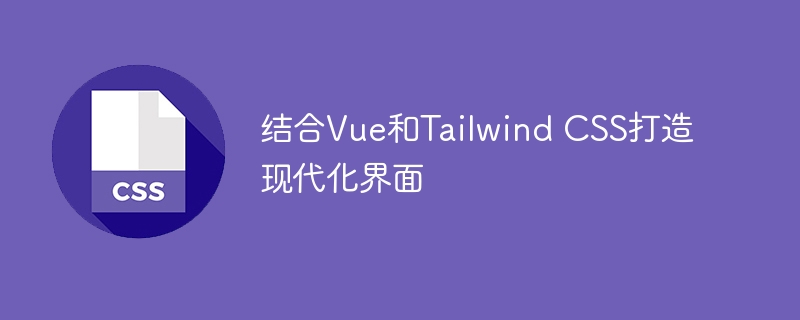Home >Web Front-end >CSS Tutorial >Building a modern interface: the perfect combination of Vue and Tailwind CSS
Building a modern interface: the perfect combination of Vue and Tailwind CSS
- PHPzOriginal
- 2023-12-27 09:50:301332browse

Vue and Tailwind CSS are both very popular tools and frameworks in modern front-end development. They have unique advantages in front-end interface and style settings respectively. This article will combine Vue and Tailwind CSS to explore how to use them to create a modern interface.
1. Introduction to Vue
Vue is a progressive JavaScript framework for building user interfaces. It focuses on the development of the UI layer, making it easy and efficient to build single page applications (SPA). Vue is flexible, scalable, and easy to maintain, so it is favored by more and more developers.
The core idea of Vue is componentization, which can split the page into small, independent components, and then build the entire page by combining the components. This makes page development and maintenance clearer and simpler. In addition, Vue also provides rich functions such as responsive data binding, virtual DOM, routing, state management, etc., making the development of SPA more efficient and convenient.
2. Introduction to Tailwind CSS
Tailwind CSS is a powerful and highly customizable CSS framework. It takes user interface design as its starting point and provides many predefined styles and components available. Unlike other CSS frameworks, Tailwind CSS does not have fixed class names or styles. Instead, it implements style definition through a large number of atomic classes. This design allows developers to freely combine these atomic classes to create styles that conform to their own design ideas.
Tailwind CSS is characterized by providing rich documents and examples to facilitate developers to learn and use. It also supports custom configuration, allowing developers to customize it according to the needs of the project to better meet specific design requirements.
3. Combining Vue and Tailwind CSS
When combining Vue and Tailwind CSS, you first need to set up the environment. You can use the Vue CLI to create a Vue-based project and introduce Tailwind CSS into the project. For specific operations, please refer to Vue official documentation and Tailwind CSS official documentation.
After introducing Tailwind CSS into the project, you can use the componentization feature of Vue to build a specific interface. Vue provides a wealth of component options and life cycle methods, making page development more flexible and efficient. At the same time, combined with the style definition method of Tailwind CSS, we can quickly add styles to components and flexibly combine and extend styles between components.
In addition, Vue also provides some special instructions and filters that can easily dynamically bind and operate elements. The combination of these functions makes the page more flexible and powerful in user interaction and data display.
4. Sample Application
The following is a simple sample application to demonstrate how to develop using Vue and Tailwind CSS.
Suppose we are developing a to-do management application where users can add, modify and delete to-do items.
First, create a Vue component to display the to-do list:
d477f9ce7bf77f53fbcf36bec1b69b7a
1fb80aeffb6ed5ea929fe489a72a049b
<h1 class="text-2xl font-bold mb-4">Todo List</h1>
<ul>
<li v-for="todo in todos" :key="todo.id" class="mb-2">
{{ todo.text }}
<button @click="deleteTodo(todo.id)" class="ml-2 px-2 py-1 bg-red-500 text-white rounded">
Delete
</button>
</li>
</ul>
<form @submit.prevent="addTodo" class="mt-4">
<input v-model="newTodo" class="border border-gray-300 px-2 py-1 rounded" placeholder="Add new todo" />
<button type="submit" class="ml-2 px-2 py-1 bg-blue-500 text-white rounded">Add</button>
</form>16b28748ea4df4d9c2150843fecfba68
21c97d3a051048b8e55e3c8f199a54b2
3f1c4e4b6b16bbbd69b2ee476dc4f83a
export default {
data() {
return {
todos: [
{ id: 1, text: 'Learn Vue' },
{ id: 2, text: 'Build awesome projects' },
{ id: 3, text: 'Master Tailwind CSS' }
],
newTodo: ''
};},
methods: {
addTodo() {
if (this.newTodo.trim() !== '') {
this.todos.push({
id: this.todos.length + 1,
text: this.newTodo.trim()
});
this.newTodo = '';
}
},
deleteTodo(id) {
this.todos = this.todos.filter(todo => todo.id !== id);
}}
};
2cacc6d41bbb37262a98f745aa00fbf0
Through the above examples, we can see that Vue and Tailwind CSS can be used to quickly build Come up with a modern interface. Through componentization, we can better control and manage the style and behavior of components throughout the development process. At the same time, by using the atomic class of Tailwind CSS, we can easily define and modify the style of the component, making the interface more flexible and customized.
Summary:
This article combines Vue and Tailwind CSS to introduce their respective characteristics and advantages, and shows how to use them together to create a modern interface. Vue's componentization and responsive data binding make developing SPA simple and efficient, while Tailwind CSS's atomic classes and customizable features provide rich style definition and combination methods. By using them together, we can more easily develop modern interfaces that meet design requirements. I hope this article will be helpful to you. Everyone is welcome to explore and try to combine Vue and Tailwind CSS for front-end development.
The above is the detailed content of Building a modern interface: the perfect combination of Vue and Tailwind CSS. For more information, please follow other related articles on the PHP Chinese website!

